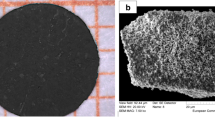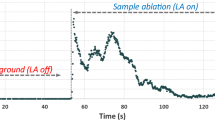Abstract
This paper presents the application of a multicollector inductively coupled plasma mass spectrometer (MC–ICP–MS)—a Nu Plasma HR—equipped with three ion-counting multipliers and coupled to a laser ablation system (LA) for the rapid and sensitive determination of the 235U/238U, 236U/238U, 145Nd/143Nd, 146Nd/143Nd, 101Ru/(99Ru+99Tc) and 102Ru/(99Ru+99Tc) isotope ratios in microsamples collected in the vicinity of Chernobyl. Microsamples with dimensions ranging from a hundred μm to about 1 mm and with surface alpha activities of 3–38 mBq were first identified using nuclear track radiography. U, Nd and Ru isotope systems were then measured sequentially for the same microsample by LA–MC–ICP–MS. The application of a zoom ion optic for aligning the ion beams into the ion counters allows fast switching between different isotope systems, which enables all of the abovementioned isotope ratios to be measured for the same microsample within a total analysis time of 15–20 min (excluding MC–ICP–MS optimization and calibration). The 101Ru/(99Ru+99Tc) and 102Ru/(99Ru+99Tc) isotope ratios were measured for four microsamples and were found to be significantly lower than the natural ratios, indicating that the microsamples were contaminated with the corresponding fission products (Ru and Tc). A slight depletion in 146Nd of about 3–5% was observed in the contaminated samples, but the Nd isotopic ratios measured in the contaminated samples coincided with natural isotopic composition within the measurement uncertainty, as most of the Nd in the analyzed samples originates from the natural soil load of this element. The 235U/238U and 236U/238U isotope ratios were the most sensitive indicators of irradiated uranium. The present work yielded a significant variation in uranium isotope ratios in microsamples, in contrast with previously published results from the bulk analysis of contaminated samples originating from the vicinity of Chernobyl. Thus, the 235U/238U ratios measured in ten microsamples varied in the range from 0.0073 (corresponding to the natural uranium isotopic composition) to 0.023 (corresponding to initial 235U enrichment in reactor fuel). An inverse correlation was observed between the 236U/238U and 235U/238U isotope ratios, except in the case of one sample with natural uranium. The heterogeneity of the uranium isotope composition is attributed to the different burn-up grades of uranium in the fuel rods from which the microsamples originated.



Similar content being viewed by others
References
Adams CE, Farlow NH, Schell WR (1960) Geochim Cosmochim Acta 18:42–56
Dibben HE, Howells H (1955) The distribution, characterisation and origin of particulate activity found in the Windscale area, July–September 1955 (UKAEA Report IGO R/W9). UKAEA, Harwell, UK
Gummer WK, Campbell FR, Knight GB, Richard JL (1980) Cosmos 954: The occurrence and nature of recovered debris (Report INFO-0006). Energy Control Board, Minister of Supply and Services Canada, Ottawa, Canada
Borovoi A, Gavrilov S (2001) Development of the database “Nuclear fuel and radioactive waste in the Shelter of Chernobyl NPP” (Preprint IBRAE-2001-01). Nuclear Safety Institute of Russian Academy of Sciences, Moscow
Boulyga SF, Zoriy M, Ketterer ME, Becker JS (2003) J Environ Monit 5:661–666
Begichev SN, Borovoj AA, Burlakov EB, Gagarinsky AJ, Demin VF, Khrulev AA, Khodakovsky IL (1990) In: Rogers JT (ed) Fission product transport processes in reactor accidents. Hemisphere, New York, pp 717–734
Kirchner G, Noack C (1988) Nucl Safety 29(1):1–5
Vajda N (2001) Radioactive particles in the environment: occurrence, characterisation, appropriate analytical techniques. International Atomic Energy Agency, Vienna
Donohue DL (2002) Anal Chem 74:28A–35A
Ciurapinski A, Parus J, Donohue DJ (2002) Radioanal Nucl Chem 251:345–352
Boulyga SF, Erdmann N, Funk H, Kievets MK, Lomonosova EM, Mansel A, Trautmann N, Yaroshevich OI, Zhuk IV (1997) Rad Meas 28:349–352
Boulyga SF, Becker JS (2001) Fresenius J Anal Chem 370:612–617
Quétel CR, Vogl J, Prohaska T, Nelms S, Taylor PDP, De Bièvre P (2000) Fresenius J Anal Chem 368:148–155
Boulyga SF, Klötzli U, Prohaska T (2006) J Anal Atom Spectrom 21:1427–1430
Boulyga SF, Tibi M, Heumann KG (2004) Anal Bioanal Chem 378:342–347
Boulyga SF (1997) Development of nuclear track radiography for determination of actinide contents in environmental samples. Ph.D. Thesis, Institute of Radiation Physics and Chemistry Problems, Minsk, Belarus
Simonetti A, Heaman LM, Hartlaub RP, Creaser RA, MacHattie TG, Bohm C (2005) J Anal Atom Spectrom 20:677–686
Brown CF, Dresel PE, Geiszler KN, Farmer OT (2006) J Anal Atom Spectrom 21:955–962
Mironov VP, Matusevich JL, Kudrjashov VP, Ananich PI, Zhuravkov VV, Boulyga SF, Becker JS (2005) Radiochim Acta 93:781–784
Acknowledgement
The authors acknowledge financial support from the Austrian Science Fund FWF (START project 267-N11).
Author information
Authors and Affiliations
Corresponding author
Electronic supplementary material
Below is the link to the Electronic supplementary material.
ESM 1
(PDF 41 kb)
Rights and permissions
About this article
Cite this article
Boulyga, S.F., Prohaska, T. Determining the isotopic compositions of uranium and fission products in radioactive environmental microsamples using laser ablation ICP–MS with multiple ion counters. Anal Bioanal Chem 390, 531–539 (2008). https://doi.org/10.1007/s00216-007-1575-6
Received:
Revised:
Accepted:
Published:
Issue Date:
DOI: https://doi.org/10.1007/s00216-007-1575-6




